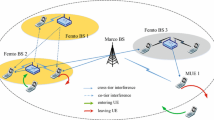Abstract
This paper proposes a model for configuring cellular networks to study the dynamics of mobility between a single cell and its adjacent cells. It differs from most models considered in the literature by explicitly incorporating the dependency between the handoff rate and the system state. Besides, the handoff rate is also a function of cell size and subscriber mobility. Extensive computational experiments were done to study the impact of various input parameters on specific performance measures. Several observations are made regarding the system performance and as to how they are affected by the complex interaction between subscriber mobility, cell size, number of channels and the mean call initiation rate. The results of these experiments show that the proposed model, where handoff rates are state-dependent, captures additional traffic due to mobility when compared to the traditional method of modeling handoffs using information about the average behavior. Finally, the economic impact of mobility on system configuration decisions is analyzed. Though an approximation, the above work provides interesting insights about the impact of mobility in configuring cellular networks.
Similar content being viewed by others
References
C.-J. Chang, T.-T. Su and Y.-Y. Chiang, Analysis of a cutoff priority cellular radio system with finite queueing and reneging/dropping, IEEE/ACM Transactions on Networking 2 (1994) 166–175.
D.E. Everitt, Traffic engineering of the radio interface for cellular mobile networks, Proceedings IEEE (1994) 1371–1382.
G.J. Foschini, B. Gopinath and Z. Miljanic, Channel cost of mobility, IEEE Transactions on Vehicular Technology 4 (1993) 414–424.
B. Gavish and S. Sridhar, Economic aspects of configuring cellular networks, Wireless Networks 1 (1995) 115–128.
W.C. Giffin, Queueing: Basic Theory and Applications (Grid, Columbus, OH, 1978).
R.A. Guerin, Channel occupancy time distribution in a cellular radio system, IEEE Transactions on Vehicular Technology 3 (1987) 89–99.
M. Herzberg and D. McMillan, State-dependent control of call arrivals in layered cellular mobile networks, Telecommunication Systems 4 (1993) 365–378.
D. Hong and S.S. Rappaport, Traffic model and performance analysis for cellular mobile radio telephone systems with prioritized and nonprioritized handoff procedures, IEEE Transactions on Vehicular Technology 3 (1986) 77–92.
S.S. Kuek, W.-C. Wong, R. Vijayan and D.J. Goodman, A predictive load-sharing scheme in a microcellular radio environment, IEEE Transactions on Vehicular Technology 4 (1993) 519–525.
Y.-B. Lin, S. Mohan and A. Noerpel, Queueing priority channel assignment strategies for hand-off and initial access for a PCS network, IEEE Transactions on Vehicular Technology 3 (1994) 704–712.
D. McMillan, Traffic modeling and analysis for cellular mobile networks, in: Proc. of Int. Teletraffic Congress (1991) pp. 627–632.
G. Naik, Cellular phone rates spark static from users,Wall Street Journal (May 5, 1994) B1.
S. Nanda, Teletraffic models for urban and suburban microcells: Cell sizes and handoff rates, IEEE Transactions on Vehicular Technology 4 (1993) 673–682.
D.L. Pallant and P.G. Taylor, Approximation of performance measures in cellular mobile networks with dynamic channel allocation, Telecommunication Systems 2 (1994) 129–163.
P. Petersen, Positioning PCS on the Telecom landscape, Telephony (December 1993) 26–32.
S.S. Rappaport, The multiple-call hand-off problem in high-capacity cellular communications system, IEEE Transactions on Vehicular Technology 3 (1991) 546–557.
S.S. Rappaport and L.-R. Hu, Microcellular communication systems with hierarchical macrocell overlays: Traffic performance models and analysis, Proc. IEEE 9 (1994) 1383–1397.
D.P. Reed, The cost structure of personal communication services, IEEE Communications Magazine 4 (1993) 102–108.
J. Sarnecki, C. Vinodrai, A. Javed, P. O'Kelly and K. Dick, Microcell design principles, IEEE Communications Magazine 4 (1993) 76–82.
R. Steele and M. Nofal, Teletraffic performance of microcellular personal communication networks, IEE Proceedings-I 4 (1992) 448–461.
S. Tekinay and B. Jabbari, A measurement-based prioritization scheme for handovers in mobile cellular networks, IEEE Journal on Selected Areas in Communications 10 (1992) 1343–1350.
R. Thomas, H. Gilbert and G. Mazziotto, Influence of the movement of the mobile station on the performance of a radio cellular network, in: Proc. 3rd Nordic Seminar (September 1988) Paper 9.4.
H. Xie and S. Kuek, Priority handoff analysis, in: Proc. IEEE Veh. Tech. Conf. (1993) 855–858.
Z. Zlatev, J. Wasniewski and K. Schaumburg, Y12M: solution of large and sparse systems of linear algebraic equations, in: Lecture Notes in Computer Science, Vol. 121 (1981).
Author information
Authors and Affiliations
Rights and permissions
About this article
Cite this article
Gavish, B., Sridhar, S. The Impact of Mobility on Cellular Network Configuration. Wireless Networks 7, 173–185 (2001). https://doi.org/10.1023/A:1016689606966
Issue Date:
DOI: https://doi.org/10.1023/A:1016689606966




